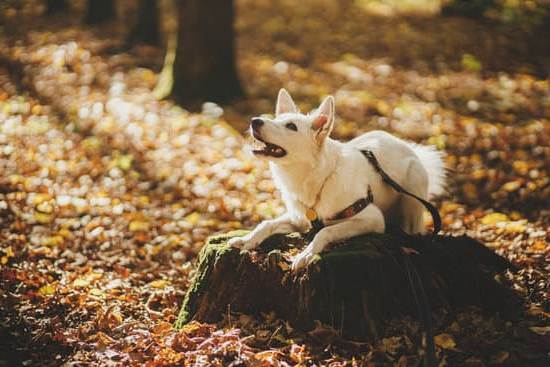Having a dog that constantly pulls on the leash can be frustrating for any pet owner. In this article, we will explore how to leash train a dog who pulls and understand the reasons behind this behavior. By using positive reinforcement techniques and consistency, you can teach your furry friend to walk politely on a leash.
Dogs pull on the leash for various reasons, including excitement, natural instincts to explore their surroundings, or simply due to lack of proper training. It is essential to address this behavior not only for your own comfort but also for the safety of your dog and others around you. By understanding why dogs pull on the leash, you can effectively work towards correcting this behavior.
Leash training is crucial for both the dog and the owner. Not only does it provide a sense of control during walks, but it also strengthens the bond between you and your canine companion. With the right tools and equipment, along with positive reinforcement techniques, you can successfully train your dog to walk politely on a leash. Stay tuned as we delve into the importance of leash training and the step-by-step guide to achieve this goal.
Importance of Leash Training for Both the Dog and the Owner
Leash training is a crucial aspect of dog ownership that benefits both the dog and the owner. Not only does it ensure the safety of your pet while out on walks, but it also promotes good behavior and strengthens the bond between you and your furry companion. Teaching your dog how to walk nicely on a leash can be a rewarding experience, but it requires patience, consistency, and positive reinforcement techniques.
Preventing Injuries and Accidents
One of the primary reasons why leash training is important is to prevent injuries to both your dog and yourself. Dogs who pull on the leash can easily dart into traffic or get tangled in obstacles, putting themselves at risk of harm.
Additionally, if your dog is not properly trained to walk on a leash, they may inadvertently trip you or pull you off balance, leading to potential injuries for you as well. By teaching your dog proper leash manners, you can create a safe walking environment for both of you.
Promoting Good Behavior
Leash training also helps instill good behavior in your dog. When a dog learns to walk calmly by your side without pulling on the leash, they are exhibiting self-control and obedience. This translates into other areas of their life as well, making them more manageable and well-behaved pets overall. It also shows that you are the leader in the relationship, which can lead to a stronger bond between you and your furry friend.
Tools and Equipment Needed for Successful Leash Training
Choosing the Right Leash and Collar
When it comes to leash training a dog who pulls, it is crucial to have the right tools and equipment to set you up for success. One of the first things to consider is choosing the appropriate leash and collar for your dog.
For dogs that tend to pull, a front-clip harness or a head halter can be effective in reducing pulling behavior. These types of equipment help redirect your dog’s attention back to you when they start pulling.
Treats and Rewards
Another essential tool for successful leash training is having plenty of treats and rewards on hand. Positive reinforcement is key in encouraging good leash behavior in your dog. By rewarding your dog with treats whenever they walk nicely on the leash without pulling, you are reinforcing this desired behavior. Make sure to use high-value treats that your dog finds irresistible to keep them motivated during training sessions.
Persistence and Patience
Aside from physical tools and equipment, one of the most important things you need for successful leash training is persistence and patience. Leash training a dog who pulls will not happen overnight, so it’s essential to be consistent with your training efforts. Remember that every dog learns at their own pace, so avoid getting frustrated if progress seems slow. With time, consistency, and positive reinforcement, you can teach your dog to walk politely on a leash without pulling.
Positive Reinforcement Techniques to Encourage Good Leash Behavior
When it comes to leash training a dog who pulls, positive reinforcement is key. Using rewards to incentivize desired behaviors can be highly effective in teaching your furry friend how to walk politely on a leash. One of the most important aspects of positive reinforcement is timing – make sure to reward your dog immediately after they exhibit the behavior you want to encourage, such as walking calmly by your side without pulling.
Another effective positive reinforcement technique is clicker training. By associating the sound of a clicker with a treat, you can communicate to your dog exactly when they are doing the right thing. Click and reward every time your dog walks nicely on the leash, reinforcing this behavior positively. Over time, your dog will learn that walking without pulling is what earns them tasty treats and praise.
Consistency is key when using positive reinforcement techniques for leash training. Make sure that everyone who walks your dog follows the same rules and uses the same rewards system. This will prevent confusion for your pet and help them understand what is expected of them while on a leash. Remember, patience and persistence are essential when teaching your dog how to walk politely, so keep up with the positive reinforcement even if progress seems slow at first.
| Positive Reinforcement Techniques | Benefits |
|---|---|
| Immediate rewards after desired behavior | Reinforces good leash behavior effectively |
| Clicker training association with treats | Clear communication for dogs on correct behaviors |
| Consistent use of rewards system | Avoids confusion and accelerates learning process |
Step-by-Step Guide on How to Teach a Dog to Walk Politely on a Leash
Leash training is an essential skill for both dogs and their owners to ensure safe and enjoyable walks. Teaching a dog to walk politely on a leash can be a challenging task, especially if your furry friend tends to pull excessively. However, with patience, consistency, and the right techniques, you can successfully train your dog to walk calmly by your side.
To effectively leash train a dog who pulls, it is important to have the necessary tools and equipment on hand. Some of the essential items include a well-fitted harness or collar, a sturdy leash (ideally 4-6 feet long), and high-value treats for positive reinforcement. These tools will help you control your dog’s movements while rewarding good behavior during training sessions.
Here is a step-by-step guide on how to teach your dog to walk politely on a leash:
- Start in a low-distraction environment such as your backyard or a quiet street.
- Put your dog’s harness or collar on and attach the leash.
- Hold the leash loosely and stand still. If your dog starts pulling, stop walking immediately.
- When your dog relaxes the tension on the leash and walks by your side, praise them enthusiastically and offer a treat.
- Practice short training sessions multiple times a day to reinforce good walking behavior.
Following these steps consistently will help your dog understand what is expected of them during walks and gradually improve their leash manners. By using positive reinforcement techniques, you can create a strong bond with your furry companion while teaching them proper walking etiquette in no time.
- Start in low-distraction environments
- Hold the leash loosely
- Stop walking when the dog pulls
- Reward good behavior with treats
- Practice multiple short training sessions daily
Common Mistakes to Avoid During Leash Training
When learning how to leash train a dog who pulls, it is important to be aware of common mistakes that can hinder your progress. One common mistake is inconsistent training. If you are not consistent with your commands and expectations during leash training, your dog may become confused and revert to pulling on the leash. It is essential to set clear boundaries from the beginning and stick to them throughout the training process.
Another mistake to avoid is using negative reinforcement or punishment. While it may be frustrating when your dog pulls on the leash, resorting to harsh corrections or punishments will not effectively teach them how to walk politely. Instead, focus on positive reinforcement techniques such as treats, praise, and rewards for good behavior. This will help create a positive association with walking nicely on a leash.
Additionally, one mistake that many owners make during leash training is not being patient enough. Dogs learn at their own pace, and some may take longer than others to grasp the concept of walking calmly on a leash. It is important to remain patient, consistent, and persistent with your training efforts. Remember that building a strong foundation of good leash manners takes time and dedication.
| Common Mistakes | How to Correct |
|---|---|
| Inconsistent training | Set clear boundaries and be consistent with commands |
| Negative reinforcement or punishment | Focus on positive reinforcement techniques like treats and praise |
| Lack of patience | Remain patient, consistent, and persistent in training efforts |
Tips for Consistency and Persistence in Leash Training
Consistency and persistence are key when it comes to leash training a dog who pulls. Without these vital components, the training process can become ineffective and frustrating for both the dog and the owner. Here are some tips to help you stay on track and successfully teach your furry friend how to walk politely on a leash:
- Establish a routine: Consistency in timing and length of walks can help reinforce good leash behavior. Dogs thrive on routine, so try to stick to a schedule that works for both you and your pet.
- Use the same commands: Using consistent commands such as “heel” or “let’s go” can help your dog understand what is expected of them during walks. Be sure to use these commands every time you leash up your pup.
- Reward good behavior: Positive reinforcement is essential in leash training. Reward your dog with treats, praise, or playtime when they walk nicely on the leash. This will encourage them to repeat this behavior in the future.
Persistence is also crucial when it comes to leash training. Remember that learning takes time, so be patient with your dog as they navigate this new skill:
- Don’t give up: Even if progress seems slow, continue to work with your dog on their leash manners. Consistency is key in reinforcing good behavior.
- Stay calm: It’s important to remain calm and composed during training sessions. Dogs can pick up on your emotions, so try not to show frustration or impatience if they struggle with pulling.
- Seek professional help if needed: If you find yourself struggling with leash training despite consistent efforts, consider enlisting the help of a professional trainer. They can provide guidance and support to ensure success.
By staying consistent and persistent in your efforts, you can help your dog learn proper leash manners and enjoy peaceful walks together for years to come. Remember, patience and positive reinforcement are key components in achieving successful results when teaching a dog how to walk politely on a leash.
Troubleshooting
If your dog continues to pull on the leash despite your best efforts at training, it can be frustrating and disheartening. However, it’s important not to give up hope. There are several strategies you can try to address this behavior and improve your walking experience with your furry friend.
One technique you can use is to try changing direction whenever your dog starts pulling on the leash. By doing this, you are teaching your dog that pulling will not get them where they want to go. It may take some time for them to catch on, but consistency is key. Rewarding your dog with treats or praise when they walk nicely beside you can also reinforce good behavior and encourage them to continue walking politely on the leash.
Another option is to incorporate more mental and physical exercise into your dog’s routine. Sometimes, dogs pull on the leash because they have excess energy that needs to be burned off. By providing regular walks, playtime, and training sessions, you can help tire out your pup and reduce their urge to pull during walks.
Additionally, using a front-clip harness or head collar can also help provide more control over your dog’s movements and discourage pulling. Remember, patience and persistence are crucial when it comes to leash training a dog who pulls. With time and dedication, you can help your furry companion become a well-behaved walking buddy.
Conclusion
In conclusion, leash training your dog is a crucial aspect of responsible pet ownership that benefits both the dog and the owner. By understanding why dogs pull on the leash and using positive reinforcement techniques, you can successfully teach your furry companion how to walk politely on a leash. The step-by-step guide provided in this article offers practical advice on how to leash train a dog who pulls, emphasizing consistency and persistence in the training process.
A well-trained dog who walks nicely on a leash not only makes daily walks more enjoyable but also enhances the bond between you and your pet. You’ll have more control over your dog’s behavior in public settings, ensuring their safety and the safety of others around them. Additionally, a well-behaved dog is more likely to be welcomed in various social situations, allowing you to include them in your daily activities with ease.
Remember that every dog is different, and some may require more time and effort when it comes to leash training. If your dog continues to pull on the leash despite your efforts, don’t get discouraged. Consider seeking guidance from professional trainers or behaviorists who can offer personalized advice for your specific situation. With patience, consistency, and positive reinforcement, you can help your canine companion learn how to walk nicely on a leash and enjoy many happy adventures together.
Frequently Asked Questions
How Do I Get My Dog to Stop Pulling on the Leash?
Training your dog to stop pulling on the leash requires consistency, patience, and positive reinforcement. One effective method is to teach your dog to walk beside you using treats or rewards to incentivize good behavior. Additionally, consider using a front-clip harness or head halter to discourage pulling and make walks more enjoyable for both you and your pet.
How Long Does It Take to Train a Dog to Stop Pulling on Leash?
The time it takes to train a dog to stop pulling on the leash varies depending on the individual dog’s temperament, age, and previous training experience. Some dogs may catch on quickly within a few weeks of consistent training sessions, while others may take longer.
It is essential to practice regularly and reinforce good behavior consistently to see lasting results.
What Is the Fastest Way to Leash Train a Dog?
The fastest way to leash train a dog is by utilizing positive reinforcement techniques such as rewarding them with treats or praise when they walk nicely beside you without pulling. Consistency is key in reinforcing this behavior, so be sure to practice short training sessions frequently rather than long, sporadic ones.
It’s important not to resort to punishment-based methods as they can lead to fear or aggression in your pet.

Welcome to the blog! I am a professional dog trainer and have been working with dogs for many years. In this blog, I will be discussing various topics related to dog training, including tips, tricks, and advice. I hope you find this information helpful and informative. Thanks for reading!





